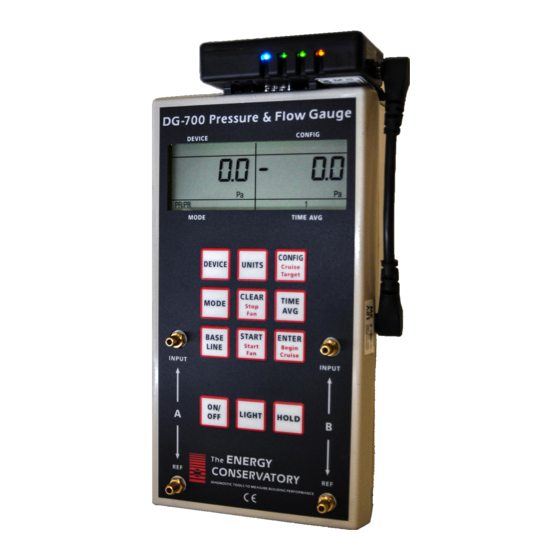Advertisement
Using the DG-700 and TECLOG3 to Measure Worst Case Fan
Depressurization and Appliance Draft
Buildings with natural draft combustion appliances should be routinely tested to ensure that the
spillage of combustion products into the building is unlikely. Combustion safety testing is critical
because of the potential for severe health effects from spillage susceptible appliances, including
carbon monoxide poisoning. Building depressurization, caused by exhaust fans, dryers,
unbalanced forced air distribution systems, and duct leakage can be a major cause of appliance
spillage. As buildings (or combustion appliance rooms) are made tighter, these problems can be
made worse, although very leaky buildings can also have venting problems related to
depressurization. One way to determine how the combustion appliances respond to changes in
building pressures is to perform a worst case depressurization test, along with an appliance draft
test.
If you have a DG-700 gauge (or a DG-500 or APT data acquisition box) and a laptop computer,
you can easily perform and graphically document these important tests. All you need is a copy of
our TECLOG3 software (available for free at www.energyconservatory.com) and a
communication cable (USB or 9-pin serial), or TEC WiFi Link to connect the DG-700 gauge to
your computer. Using TECLOG3 along with your DG-700 gauge you can capture and record the
two best indicators of venting performance, namely the pressure in the Combustion Appliance
Zone (CAZ) and the appliance draft pressure. (Consult Chapter 10 of the Minneapolis Blower
Door Operation Manual for more details on combustion safety testing.)
Getting Started/Example File
Below is a quick summary of what is involved in performing these tests. This summary uses an
Example Test File recorded on a house with a natural draft water heater (the furnace was sealed
combustion). The DG-700 gauge is located in the CAZ for this test.
1. Set up your DG-700 gauge to measure both the CAZ pressure and the vent pressure for a
natural draft appliance. Since we want to measure the CAZ pressure with reference to
outside, you will need to connect the Channel A Reference tap to the outside using a long
piece of tubing. Leave the Channel A Input tap open to the CAZ. Connect the Channel B
Input tap to a static pressure probe installed in the appliance vent. Leave the Channel B
Reference tap open to the CAZ.
2. You will need to create a communication link between the DG-700 gauge and your laptop.
You have two options to create this link.
Physically connect the laptop to the DG-700 gauge using a USB or 9 pin
•
communication cable. This will typically require the laptop to be in the CAZ. Note:
go to
http://www.energyconservatory.com/support/user-tips#1
using the DG-700 communication ports.
Or, use a TEC WiFi Link to create a wireless communication link between the gauge
•
and the laptop. This will allow the laptop to be almost anywhere in the house. Note:
see documentation that came with the WiFi Link.
3. Start TECLOG3 and open the Configuration Settings
window (click on Configuration....Settings). Enter 1.0
seconds into the Sample Interval field (this tells
TECLOG3 to take one second average pressure readings).
October 2013
1
for information on
Advertisement
Table of Contents

Subscribe to Our Youtube Channel
Summary of Contents for TEC DG-700
- Page 1 If you have a DG-700 gauge (or a DG-500 or APT data acquisition box) and a laptop computer, you can easily perform and graphically document these important tests. All you need is a copy of our TECLOG3 software (available for free at www.energyconservatory.com) and a...
- Page 2 View and Edit Channel Settings button). In the Label fields, type in appropriate labels for Channels A and B on the DG-700. These labels will appear on the graph generated by TECLOG3. Leave the Channel Type set to Pressure. You can choose the graph color that will be displayed for each channel by clicking on the color square.
- Page 3 Other Hints If you are using the TEC WiFi Link to wirelessly communicate with you laptop, try using our mobile iTEC-700 app instead of the laptop to monitor changes in pressures real-time while walking around the house with your mobile device, turning fans on and off.








Need help?
Do you have a question about the DG-700 and is the answer not in the manual?
Questions and answers